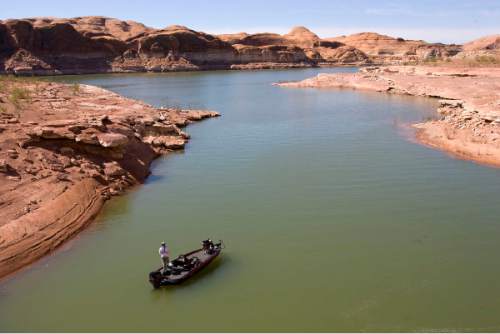This is an archived article that was published on sltrib.com in 2016, and information in the article may be outdated. It is provided only for personal research purposes and may not be reprinted.
The state Records Committee has concluded that a plan for paying for the estimated $1 billion Lake Powell Pipeline likely does exist — but it's unclear when or whether the public will be able to see it.
The Utah Rivers Council requested a copy of the draft repayment model after the Washington County Water Conservancy District — one of the parties required to come up with a way to pay for the project — questioned the accuracy of a University of Utah report that predicted the county would have to raise water rates by at least 500 percent to pay off the debt.
In criticizing the U. professors' conclusions, the manager of the water district — which would receive 26.7 billion gallons of water a year from the proposed pipeline — told The Tribune and other media that the district's payment plan could refute the U. report, but said he could not release the plan because it was incomplete.
And when Zach Frankel, executive director of the Utah Rivers Council, filed an open-records request for the draft, the water district responded by saying it did not have such records and could not fulfill his request.
After unsuccessfully appealing the district's denial, Frankel brought the case before the state Records Committee on Thursday, arguing that the model does exist and should be made public.
"The financial model has been cited in scores of media accounts. It has been widely referred to in public meetings. It has been presented in public meetings," Frankel said. "Now we come to learn that the document is a secret, shouldn't go to the public, and doesn't exist. ... This is a game of hide-and-seek."
The records committee also heard from Tom Butine, board president for Conserve Southwest Utah, who testified that as a member of a citizen advisory committee assembled by the water district, he was privy to a 2013 meeting where a financial model for the pipeline was discussed at length.
Gabriel Lozada, one of the economists who authored the U. report, also testified that Jeremy Aguero, an economic consultant based in Las Vegas, had given him a brief digital tour of the model on his computer when Lozada contacted him to trade notes.
Speaking on behalf of the Washington County Water Conservancy District, Fred Finlinson said the district had hired Aguero as a consultant to create an "interactive analytical exercise" for the 2013 meeting. But the water district does not have a copy of what was presented at that meeting, he said, and any model built by Aguero remains his property.
Finlinson also said the Rivers Council is "rarely capable of being a worthy opponent" because of its inability to stick to relevant arguments and "would use any means to derail" the pipeline project.
"The rest of their presentation is basically a bunch of hearsay based on what was reported in the paper," Finlinson said.
The state Records Committee, which was provided with screenshots and later looked up a YouTube video showing an unidentified man presenting a spreadsheet at the 2013 meeting, was not convinced a financial model didn't exist.
"In my mind, if they contracted with a consultant to create this model, which he had to do in order to have this public meeting, then the Excel file exists," said committee member Doug Misner.
Chairwoman Patricia Smith-Mansfield agreed. "Government entities cannot hide behind the contractor and say we don't own the information" to avoid fulfilling a records request.
But whether the law could force the water district to release the model to the public could depend on the terms of the district's contract with Aguero, she said.
Finlinson had not brought a copy of the contract to the meeting, but said he could get one for the committee to review.
The records committee voted unanimously for a continuance of the hearing in May.
In a poll commissioned earlier this year by The Salt Lake Tribune and the Hinckley Institute of Politics, 51 percent of surveyed Utah voters said their support for the Lake Powell Pipeline hinged on the cost of the project.
Twitter: @EmaPen



